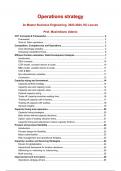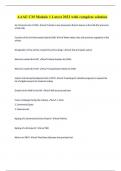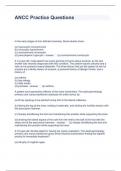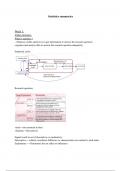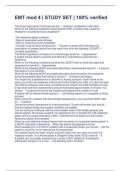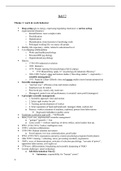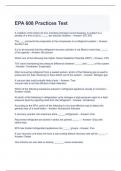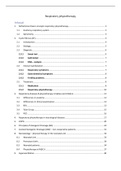PSYCHOLOGICAL ASSESSMENT
,Notes include:
▪ Study notes 1 – 10
▪ Prescribed articles
▪ 2019 Asignment 1 & Answers
▪ Examination papers and answers of Section A
& B of:
➢ October 2011
➢ May 2012
➢ October 2012
➢ January 2013
➢ October 2013
➢ January 2014
➢ October 2014
➢ January 205
➢ October 2015
➢ January 2016
➢ October 2016
➢ January 2017
➢ October 2017
➢ January 2018
➢ October 2018
➢ January 2019
, STUDY NOTES 1 for PYC4807
Please note that the study notes are based on the prescribed material but are not included
in the prescribed material. You decide if you want to make use of these notes.
Theme 1 Psychometric theory
Introduction
Ultimately, you want to use a test or tests as part of the assessment process to help a client
with a specific problem in a specific context. But first you need sufficient knowledge of the
different types of tests that are available. You need to be able to evaluate tests in terms of the
suitability for your client. This evaluation process is based on certain general theoretical
principles that apply to all tests. That is what the first theme is all about, the principles of
psychometric theory that enables you to develop suitable tests and evaluate existing tests in
terms of the suitability for a specific problem and context.
Certain sections in chapter 3 (3.2, 3.3 and 3.5) will help you to refresh your knowledge on basic
statistical concepts.
The concepts of the mean and standard deviation are important in understanding the use of
norms while the correlation serves as basis for reliability and validity coefficients. A section on
the correlation coefficient from the second-year module on questionnaire design, follows
below. Please note that this material serves as background information and does not form
part of the syllabus.
Study notes 2 will be on Topic 1.1 Psychometric properties. In Tutorial Letter 102 an overview
of the topic is provided. For more detail on each aspect, specific resources are noted where
relevant. The chapters in the prescribed book provide you with the theoretical knowledge on
the topic. Once you have studied these chapters, you will understand the application of the
theory as described in the articles. As students of psychological assessment, you will find the
articles interesting and we recommend that you read the whole article to broaden your
knowledge of the field. However, we have indicated what part of each article you need to
focus on for the purpose of this module.
Now study
Topic 1.1 in Tutorial Letter 102;
Chapters 3 (section 3.6), 4, 5 and 7* in the prescribed book; and
The articles by Gadd and Phipps (2012), Gradidge and De Jager (2011) and Oosthuizen and
Phipps (2012).
*See the comment in Tutorial Letter 102 on the level of detail on bias required in chapter 7.
, Topic 1.1 in Tutorial Letter 102
Topic 1.1 Psychometric properties
Psychological assessment is applied in various contexts (you will learn more about this in
theme 3).
In each context, the purpose of testing needs to be specified before an assessment battery
(i.e. the combination of psychological assessment measures that will be used) can be
assembled. A measure is evaluated in terms of a number of characteristics before including it
in the battery.
• First, one should consider what attribute, characteristic or construct it measures (various
types of measures will be discussed in theme
• Second, its appropriateness for an individual, group or organisation should be determined.
This implies that one should be familiar with the characteristics of the group or context that
the measure was developed for. The group should be representative of your client.
• Third, one should determine if the measure is psychometrically sound. In this regard, the
Employment Equity Act as discussed by Foxcroft and Roodt (2018) (chapter 2, section
2.4.4.2) refers to the properties of validity, reliability and equivalence.
1.1.1 Norm-referenced and criterion-referenced measures.
Many psychological assessment measures are norm referenced. This implies that an
individual’s score on the measure is interpreted by comparing this score to the performance
of people similar to himself or herself. A norm is defined in Foxcroft and Roodt (2018)
(chapter 3, section 3.6) as “a measurement against which the individual’s raw score is
evaluated so that the individual’s position relative to that of the normative sample can be
determined”.
The normative sample refers to the group of people on whom the test was initially
standardised during the test development process. Therefore, it stands to reason that a test
should be standardised on a representative group of the population for which the test is
intended (e.g. secondary school learners, apprentices or first-year students). If you
administer a psychological test to a test taker, you should be sure that there is an
appropriate norm group with which the score of the test taker could be compared.
The need for local standardisations of psychological tests developed in other countries is
emphasised in the articles by Gadd and Phipps (2012) and Oosthuizen and Phipps (2012).
These authors focused specifically on neuropsychological tests. Note: When reading these
articles, you need to consider only the characteristics of the international norm groups in
comparison to those of the local norm groups.


